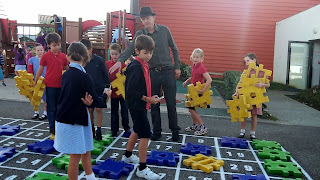Year 5G had a look at a great game, where the object is to create shapes with the classical "straight edge and compass" techniques:
http://sciencevsmagic.net/geo/ It's author is Nico Disseldorp.
What's so good about this is that:
- It's a game! How this geometry should be. Maybe how it was for the ancient Greeks before someone wrote it all down and it had to be "learnt".
- It constrains you. You can only put your lines and circles in certain places. You have to follow the rules.
- It starts easy and gets harder, and records your progress.
We had a go with physical rulers and pairs of compasses first. We created all sorts of precise diagrams, and deviated off to some really beautiful ones that some of the children wanted to finish off at home.
 |
| by Amandine |
But, with the kind permission of the people who'd done some of the pictures that weren't quite right (and it's OK to make mistakes in this classroom) we looked at how they were wrong. After all, these are not uncommon mistakes, and understanding them helps us understand something about knowledge itself. Here's one attempt to make a regular hexagon (it's in pencil so it didn't scan very clearly):
We could see here that the problem was that although the bottom points had been arrived at by finding the precise place where the circles cross, the top ones were, well, guessed at. You might call this kind of guess an informed opinion; we wanted something closer to a fact.
This one used the circles to draw all the points of the hexagon:
This is a lot closer to regular, but suffers from a lack of precision in the drawing.
So, armed with these reflections, we all managed - sometimes it took several goes, and tuition from those who got there first - we all managed to draw a good regular hexagon.
Then we went on to the Ancient Greek Geometry game / puzzle. Here we were helped to get over the problems of drawing by hand by being forced to be precise and to define points with known lines and circles.
One of the interesting things was that ten year olds can be quicker than their teacher! Jose showed Mr Gregg how to do the square, and Sophie showed him a quicker way of doing circle pack three!

















































